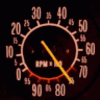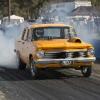I really dislike the American way of classifying cams; it leads people to think that something like the LSA is a fundamental factor when in fact it's only a derivative. In other words I don't think you should let yourself get distracted by LSA numbers; if you select appropriate figures for the four valve events the LSA will look after itself. Maybe just work out the LSA afterwards as a sanity check.
I think it's useful when studying things like this to look at the extremes - often it'll highlight what's really happening quite quickly. At one end of the scale we have the racing engines of several decades ago, with close LSAs, lots of overlap and gentle profiles. Cams like these can be bloody horrible but unfortunately it was the only way to be competitive with the poorer breathing, poorer burning and fragile valvetrains of engines of the time. The earlier intake opening helped breathing greatly and made up for all the shortcomings. Peak torque was up, but width of powerband was down. There are a few reasons for this: one is that the early intake closing limits the post-peak torque. Another is that the long overlap period makes the engine extremely vulnerable to the effects of reversion and out-of-phase pipes. Both of these are exaggerated by the late exhaust closing, and for any engine like this to work well it's absolutely essential that the exhaust system is well tuned. Despite all the downsides though it does help crutch a "poor" engine. A more modern approach though would be to use a wider LSA with a much more advanced intake CL - for some reason it was thought in the old days that the lobe centrelines needed to be not-too-far from evenly spaced either side of TDC, I have no idea why. Anyhow, a closer LSA will be peakier and a peaky engine often feels stronger even if it isn't, and this might be why some people like them. And if you build things like Holden sixes you’re stuck with them anyway just to compensate for the poor breathing.
At the other end of the scale we have the much better breathing modern two and four valve engines. They can make very good power without needing much if any overlap (and again, overlap is just a derivative, it doesn't do anything useful in itself). Very wide LSAs work quite well and they avoid all the negatives of the close angles. Of course, you can still increase the peaks slightly by closing up the LSA but the benefit isn't as great as what you get from the old wheezers, and with four-valvers in particular there's a greater chance of fresh charge heading straight out the exhaust. Besides, you can often reach the practical rpm limits of these engines without using a hell of a lot of cam anyway. So what we can deduce from these two extremes is that the benefits of a close LSA are greatest when the engine is fundamentally weak, and smaller or non-existent with a well-breathing modern design. And of course there are infinite shades in between.
Short version: ignore the LSA, just get the valve events right and let the LSA sort itself out. Old style wheezers run a close LSA to lift the torque peak, but there are downsides and it's important that the exhaust works. And for an old engine it may pay to consider a moderate LSA with a more aggressively advanced intake CL over an old school design.
Edited by oldjohnno, 22 August 2014 - 10:57 PM.




 View Garage
View Garage












